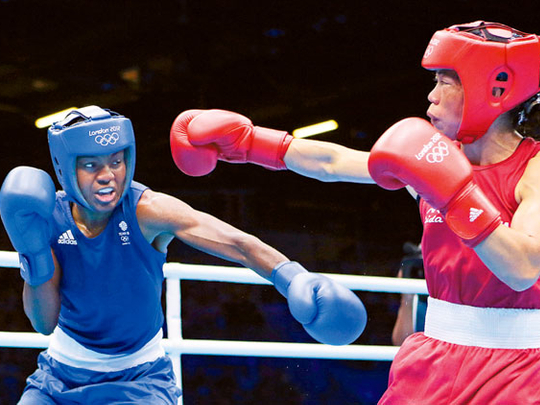
When Mary Kom from Manipur, a state in northeast India, won a boxing bronze medal at the London Olympics, the media pulled out all the stops in celebration. The podium finish is worth its weight in gold as it gives a fillip to women’s boxing in India. In stark contrast are the recurring visuals of migrants from northeastern states fleeing India’s urban centres like Bengaluru, Hyderabad and Chennai!
How did this panic spread like a contagion? In India, even seemingly simple things become complicated, leave alone complex issues with roots in ethnicity and identity. The northeast comprises a vast geographical area and is connected to mainland India through a sliver of land; it is home to different sub-cultures and borders several neighbouring countries such as Bangladesh and Myanmar. These states are euphemistically called the seven sisters of the northeast and have a long history of strife, rebellion and separatism; in some ways the issue is far more complicated than Kashmir.
The likely cause for this sudden crisis appears to be connected to the recent spate of violence in Assam between the Bodos and the other communities living in and near Bodoland — an area located in the north bank of the river Brahmaputra by the foothills of Bhutan and Arunachal Pradesh. The latter, one of the seven sisters, is incidentally claimed in full or at least in large measure by China.
No wonder then that Prime Minister Dr Manmohan Singh observed that “what is at stake is the unity and integrity of our country”. The seriousness of the situation was reflected in proceedings in the Lower House of parliament. Lawmakers called for a change in the entire political establishment. The ruling alliance as well as opposition groups rallied and addressed the nation at large, pleading for understanding and sensitivity in dealing with the crisis.
Dangerous rumours
Yet these bland avowals do not add up. For starters, no one has stepped up to claim responsibility for the threats against people from northeast India. Who is behind these rumours that initially spread through word-of-mouth and were supplemented by texts and postings on social media networks? Why is Bengaluru at the epicentre of this bizarre panic? While Hyderabad and Chennai have had their share of this contagion, the worst of this crisis was seen in Bengaluru!
It is far too early to trot out explanations, but to be fair the Karnataka Chief Minister Jagdish Shettar and the police have done all they can to restore confidence in Bengaluru. Has an underbelly of intolerance and an aggressive assertion of local identity given extra legs to this virus? There exists in the state a vocal moral brigade that insists on dress codes for women. They shout slogans outside private clubs and are against western social behaviour.
The people from the northeast have physical features that are different, their dress and social manners are more western and a large proportion of them are Christian converts. This may not go down too well with some fundamentalists in Bengaluru. That said, one must also point out that racial slurs and incidents of sexual assault against women from the northeast have been far greater in Delhi and in northern parts of India than in Bengaluru. We perhaps are too close to the events to come to any definitive understanding as to why this city was at the centre of the crisis, but a bigger question concerns not just Bengaluru, but India itself.
New media
How is the country to cope with challenges like these in the age of new media? We are not just talking of Facebook and Twitter as much as ubiquitous text messages sent on lowly cellphones. The power of these devices in mobilising mass movements was evident in the recent anti-corruption movements in Delhi. But when they become force multipliers for spreading bizarre rumours, we are in deep trouble.
The Indian state has a default position when it comes to fighting terrorism or communal conflagration. It’s not always successful, but at least it has a drill worked out. This crisis opens up far greater challenges. Unfounded, unverified and wild rumours swaying large sections of the population to flee pose a grave risks. No doubt, at the heart of this crisis is the union of India’s total abdication in evolving a national identity that encompasses the northeast.
The long years of neglect and the isolation due to poor transport links with the rest of India have all played a part in fanning this feeling of being a bystander in the unfolding India story. In the recent presidential elections, the country lost a great opportunity to mainstream the northeast by electing the first tribal president of India. P.A. Sangma would have given the northeast a sense of belonging and helped enormously in forging a national identity that is inclusive — celebrating the rich diversity of India.
Ravi Menon is a Dubai-based writer working on a series of essays on India and on a public service initiative called India Talks.









